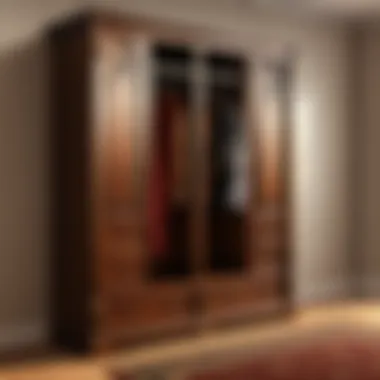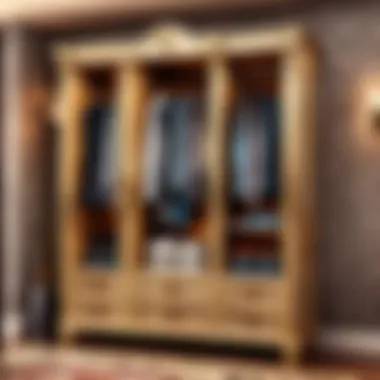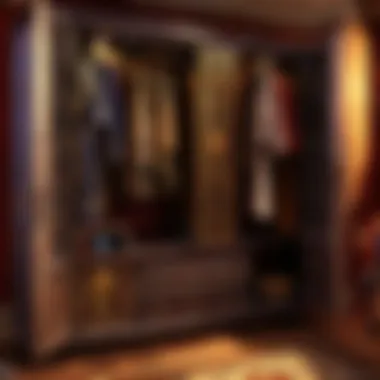Elegant Solutions for Wardrobe Design Optimization in a Room Setting


Game Updates and Patch Notes
In the realm of room design, the concept of wardrobe functionality is akin to a strategic gameplay update; it influences not just the aesthetics but also the practicality of the space. Much like a game patch, optimizing wardrobe design involves meticulous planning and attention to detail. Just as players eagerly anticipate game updates for enhancing their playing experience, homeowners seek to upgrade their wardrobes for improved organization and visual appeal. This section will delve into the intricacies of wardrobe design, drawing parallels between design strategies and gaming updates.
Strategy Guides and Tips
When it comes to optimizing wardrobe space, one must adopt a mindset similar to that of a seasoned gamer strategizing their game plan. Just as different classes in a game possess unique strengths and weaknesses, each wardrobe layout can cater to specific storage needs and style preferences. Understanding the optimal playstyles of various classes translates into grasping the most efficient organization methods for different wardrobe items. From class-specific strategies to campaign walkthroughs, this section will equip readers with the essential tactics needed to conquer clutter and elevate room aesthetics.
Lore and Story Analysis
Beyond mere aesthetics, every wardrobe design carries a narrative – a story of functionality, personal style, and spatial optimization. This narrative mirrors the immersive storytelling found in games like World of Warcraft, where characters, factions, and world events weave intricate lore. By delving into the history and current storyline of wardrobe design trends, one can uncover the motivations behind design choices and speculate on future style developments. Just as gamers immerse themselves in the rich lore of their favorite games, homeowners can engage deeply with the storyline of their wardrobe design journey.
Mod Reviews and Add-ons
In the virtual realm of gaming, mods and add-ons serve as crucial tools for enhancing gameplay, customization, and overall user experience. Similarly, when exploring wardrobe design, integrating smart storage solutions and innovative accessories can be considered as 'modding' your wardrobe space. From popular mods that offer creative storage solutions to user-generated content that provides unique design inspirations, this section will introduce readers to the world of wardrobe 'mods'. By following installation guides akin to configuring mods in a game, individuals can personalize their wardrobe setup, elevating it from a basic storage unit to a customized and functional space.
Introduction
As we step into the realm of wardrobe design within a room, we are transported into a domain where functionality meets aesthetics seamlessly. The aspect of wardrobe design is crucial in interior spaces as it not only serves as a utilitarian storage unit but also plays a significant role in enhancing the visual appeal of the room. In this article, we will dissect the nuances of wardrobe design, unraveling the key principles that govern the creation of an efficient and stylish storage solution.


Wardrobe design is not just about cramming clothes into a cabinet; it is an art that intertwines the user's needs with the spatial constraints of the room. By understanding the importance of effective wardrobe design, individuals can revolutionize the way they utilize space within their living environment. From considering the dimensions of the room to aligning the design with the interior style, each aspect contributes to the harmonious fusion of form and function.
Delving deeper, we explore the factors that one must take into account when conceptualizing a wardrobe design. The room size plays a pivotal role as it dictates the scale of the wardrobe, ensuring that it fits seamlessly into the allocated space without overwhelming the surroundings. Simultaneously, understanding the user's needs is paramount; a well-designed wardrobe should cater to the individual's storage requirements, promoting organization and accessibility. Moreover, integrating the interior style into the wardrobe design fosters a cohesive aesthetic that resonates with the overall ambiance of the room.
Efficiency is key in the realm of wardrobe design, and maximizing space is a significant aspect that cannot be overlooked. By optimizing the layout and storage solutions, individuals can unlock the full potential of their wardrobe, creating a functional and visually pleasing setup. Through strategic planning and innovative design choices, it is possible to transform a mere storage unit into a statement piece that elevates the entire room.
Understanding Wardrobe Design
Wardrobe design plays a pivotal role in the overall aesthetics and functionality of a room. A well-designed wardrobe not only enhances the visual appeal of the space but also contributes significantly to optimizing storage and organization. Understanding the intricacies of wardrobe design is essential for creating a harmonious blend of style and utility within a room. By delving into key aspects such as storage solutions, layout considerations, and material choices, one can achieve a wardrobe setup that not only meets practical needs but also elevates the overall design scheme of the room.
Importance of Effective Wardrobe Design
Effective wardrobe design is imperative for maximizing storage efficiency and ensuring seamless integration with the room's decor. A well-designed wardrobe offers ample storage capacity while maintaining a clutter-free and organized environment. By meticulously planning the layout and incorporating innovative storage solutions, one can create a functional and visually appealing wardrobe space that enhances the overall room design. Effective wardrobe design maximizes space utilization, improves accessibility to clothing and accessories, and enhances the aesthetic appeal of the room.
Factors to Consider
- Room Size: The room size plays a crucial role in determining the scale and design of the wardrobe. A larger room size offers more flexibility in terms of wardrobe dimensions and configurations, allowing for expansive storage solutions. On the other hand, smaller room sizes require clever space-saving techniques and optimized storage systems to make the most of limited space. Understanding the room size enables design decisions that align with the available space and enhance the functionality of the wardrobe.
- User's Needs: Tailoring the wardrobe design to meet the user's specific requirements is essential for creating a personalized and functional storage solution. Considerations such as the number of clothing items, accessories, and preferred organization methods influence the design of the wardrobe. By prioritizing user needs, one can customize the internal layout, storage compartments, and accessory features to maximize convenience and usability.
- Interior Style: The interior style of the room sets the tone for the wardrobe design, informing decisions on materials, colors, and finishes. Whether opting for a minimalist, modern aesthetic or a classic, traditional ambiance, integrating the wardrobe seamlessly with the room's interior style is crucial for a cohesive design. Harmonizing the wardrobe design with the overall decor theme creates a cohesive and visually appealing space that exudes sophistication and style.
Maximizing Space
Efficient space utilization is a key focus in wardrobe design, especially in rooms with limited square footage. Maximizing space involves strategic planning of storage compartments, utilizing vertical space effectively, and minimizing wasted areas. Incorporating multi-functional elements such as pull-out drawers, built-in shelves, and hanging rods optimizes storage capacity without compromising accessibility. By prioritizing space-maximizing solutions, one can create a practical and visually pleasing wardrobe design that enhances the functionality of the room.


Innovative Wardrobe Features
When delving into the realm of wardrobe design, understanding the pivotal role of innovative features is paramount. Innovative wardrobe features not only elevate the visual appeal of a room but also enhance its functionality significantly. These features go beyond mere storage solutions, aiming to streamline everyday living and offer a touch of sophistication to the space. For instance, incorporating cutting-edge designs like sliding doors or swing doors can revolutionize the accessibility and aesthetics of a wardrobe. Additionally, the integration of built-in lighting can not only illuminate the contents of the wardrobe but also add a layer of ambiance to the room. Moreover, customizable shelving provides the versatility to adapt the wardrobe according to individual preferences and storage needs. The careful consideration and implementation of these innovative features can truly transform a mundane wardrobe into a statement piece within the room, blending style with practicality effortlessly.
Sliding Doors vs. Swing Doors
One of the key decisions in wardrobe design revolves around choosing between sliding doors and swing doors. Sliding doors offer a sleek and modern look to the wardrobe, ideal for rooms with limited space where traditional swing doors may impede movement. They glide smoothly along tracks, saving considerable floor space and adding a contemporary touch to the room. Conversely, swing doors provide a classic and elegant appeal, allowing full access to the wardrobe at once. They exude a sense of grandeur and are favored for larger spaces where the swinging motion does not pose a hindrance. When deciding between these options, factors such as room size, personal style, and practicality should guide the choice to ensure a harmonious blend of aesthetics and functionality.
Built-In Lighting
The inclusion of built-in lighting in wardrobe design is a game-changer in elevating the functionality and allure of the space. Built-in lights offer visibility to the contents of the wardrobe, making it easier to locate items, especially in low-light conditions. Whether integrated into shelves, rods, or the ceiling of the wardrobe, lighting solutions can enhance the overall ambiance of the room. LED strips, spotlights, or sensor-activated lights are popular choices that not only illuminate the wardrobe efficiently but also add a touch of luxury to the room. Careful placement and selection of lighting fixtures play a crucial role in creating a well-lit and inviting wardrobe space that marries functionality with style seamlessly.
Customizable Shelving
When it comes to maximizing storage efficiency and personalizing the wardrobe space, customizable shelving emerges as a key aspect of wardrobe design. Customizable shelving allows individuals to adapt the storage layout according to their specific needs, whether accommodating tall items, shoes, folded clothes, or accessories. Adjustable shelves, pull-out racks, and modular units offer versatility and organization, ensuring every inch of the wardrobe is utilized effectively. By customizing the shelving configuration to suit varying storage requirements, individuals can achieve a clutter-free and tailored wardrobe setup that aligns perfectly with their lifestyle and preferences.
Aesthetics and Style
In the realm of wardrobe design, aesthetics and style play a pivotal role in creating a visually appealing and cohesive room setup. The interplay between color schemes, material selection, and inclusion of mirrors can significantly enhance the overall ambiance and utility of the wardrobe space. A well-thought-out aesthetic approach not only elevates the room's design but also influences the user's daily experience and interaction with their belongings.


Color Schemes
Color schemes hold immense significance in wardrobe design as they set the tone for the entire room. Selecting the right color palette can create a sense of harmony, extension of space, and reflect personal style preferences. Neutral colors like white, beige, or grey can impart a timeless elegance and openness to the room, while bolder hues such as navy, burgundy, or emerald can bring in a touch of luxury and drama. Understanding color psychology is crucial in choosing shades that promote relaxation, creativity, or productivity, depending on the room's purpose. Harmonizing the wardrobe's color scheme with the room's existing decor can achieve a cohesive look that is both visually pleasing and functional.
Material Selection
Material selection in wardrobe design is a critical aspect that influences durability, aesthetics, and cost-effectiveness. Opting for high-quality materials like solid wood, laminates, or glass can ensure longevity and a sophisticated finish. Each material has its unique characteristics; for instance, wood exudes warmth and authenticity, glass imparts a modern flair, and laminates offer versatility and ease of maintenance. Considering factors such as affordability, maintenance requirements, and design preferences is essential when choosing materials for wardrobes. Additionally, integrating eco-friendly and sustainable materials aligns with the contemporary trend towards environmentally conscious living, promoting both style and ethical considerations.
Incorporating Mirrors
Mirrors serve as multifunctional elements in wardrobe design, enhancing aesthetics while adding practical value. Installing mirrors on wardrobe doors or as standalone panels not only create an illusion of spaciousness but also facilitate easier outfit coordination and grooming rituals. Mirrors reflect natural light, brightening the room and making it appear larger, which is particularly beneficial in smaller or dimly lit spaces. Various mirror styles, such as antique, beveled, or frameless, can be incorporated based on the desired aesthetic impact and functional requirements. Strategic placement of mirrors within the wardrobe layout can optimize lighting, create visual interest, and streamline daily grooming activities.
Organization and Functionality
Wardrobe organization and functionality play a pivotal role in ensuring an efficient and aesthetically pleasing setup within a room. Effective organization creates a sense of order and convenience, optimizing space utilization and enhancing the overall user experience. Functionality, on the other hand, focuses on the ease of access, maneuverability, and user-centric design aspects of the wardrobe. When exploring wardrobe design within a room, it is crucial to prioritize organization and functionality to achieve a harmonious balance between practicality and visual appeal.
Drawer Systems
Drawer systems are integral components of wardrobe design that offer unparalleled organization and usability. Opting for drawer systems provides a structured approach to storing clothing, accessories, and personal items. The versatility of drawer systems enables users to categorize and segregate their belongings efficiently, aiding in quick retrieval and a clutter-free environment. Considerations such as drawer depth, width, and partitioning are essential to tailor the system to individual preferences and storage needs. With smooth sliding mechanisms and ergonomic handles, drawer systems enhance the overall functionality of the wardrobe, making everyday tasks seamless and convenient.
Accessory Compartments
Accessory compartments serve as specialized storage spaces tailored for jewelry, watches, ties, scarves, and other accessories. These compartments are designed to preserve the quality and condition of delicate items while ensuring easy access and visibility. Incorporating accessory compartments within the wardrobe optimizes organization and prevents items from getting misplaced or tangled. The thoughtful arrangement of these compartments enhances the aesthetic appeal of the wardrobe and imbues a sense of luxury and sophistication. By customizing compartment sizes and layouts, users can personalize their storage solutions to align with their wardrobe necessities and style preferences.
Hanging Solutions
Hanging solutions are essential components that facilitate the neat and proper storage of clothing items that are best kept on hangers. Providing ample hanging space within the wardrobe enhances accessibility and minimizes creases and wrinkles on garments. Various hanging solutions, such as rods, hooks, and pull-out valet rods, cater to different clothing types and storage requirements. Optimizing hanging solutions requires strategic placement and consideration of garment lengths and styles to maximize space utilization and visual neatness. Incorporating diverse hanging options ensures flexibility and versatility in organizing clothing items, contributing to a well-structured and functional wardrobe design.







